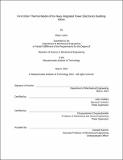| dc.contributor.advisor | Chryssostomidis, Chryssostomos | |
| dc.contributor.advisor | Chalfant, Julie | |
| dc.contributor.author | Lietch, Ethan | |
| dc.date.accessioned | 2022-08-29T15:50:57Z | |
| dc.date.available | 2022-08-29T15:50:57Z | |
| dc.date.issued | 2022-05 | |
| dc.date.submitted | 2022-06-14T19:35:26.087Z | |
| dc.identifier.uri | https://hdl.handle.net/1721.1/144489 | |
| dc.description.abstract | To accomplish the United States Navy’s goal of developing a fully electric warship, it is essential to cool critical electronic components within the Navy integrated Power Electronics Building Block (iPEBB) for it to function at its full capacity. The current study develops a first order analytical understanding of the most prolific heat transfer modes within the iPEBB and identifies critical constraints for the design of future cooling systems. The main heat loads within the iPEBB are the rows of MOSFET switches generating 4752 W of waste heat and the transformer which generates 858 W through the outer protective wall. The analysis presented in this thesis defines the critical temperatures and heat fluxes of the critical heat generating sources and can be used as a benchmark for future thermal cooling design. | |
| dc.publisher | Massachusetts Institute of Technology | |
| dc.rights | In Copyright - Educational Use Permitted | |
| dc.rights | Copyright MIT | |
| dc.rights.uri | http://rightsstatements.org/page/InC-EDU/1.0/ | |
| dc.title | First Order Thermal Model of the Navy integrated Power Electronics Building Block | |
| dc.type | Thesis | |
| dc.description.degree | S.B. | |
| dc.contributor.department | Massachusetts Institute of Technology. Department of Mechanical Engineering | |
| mit.thesis.degree | Bachelor | |
| thesis.degree.name | Bachelor of Science in Mechanical Engineering | |
